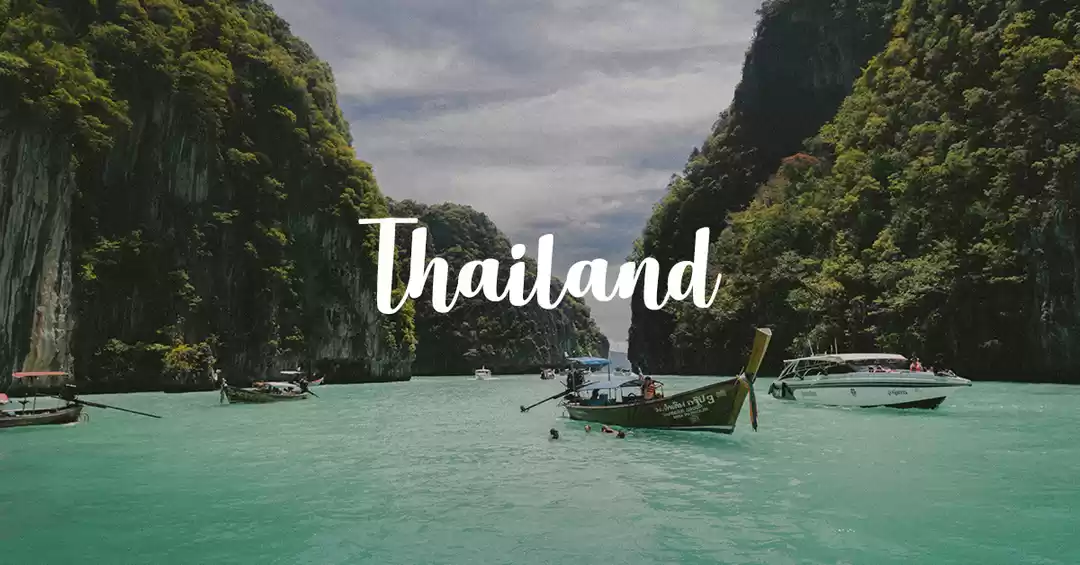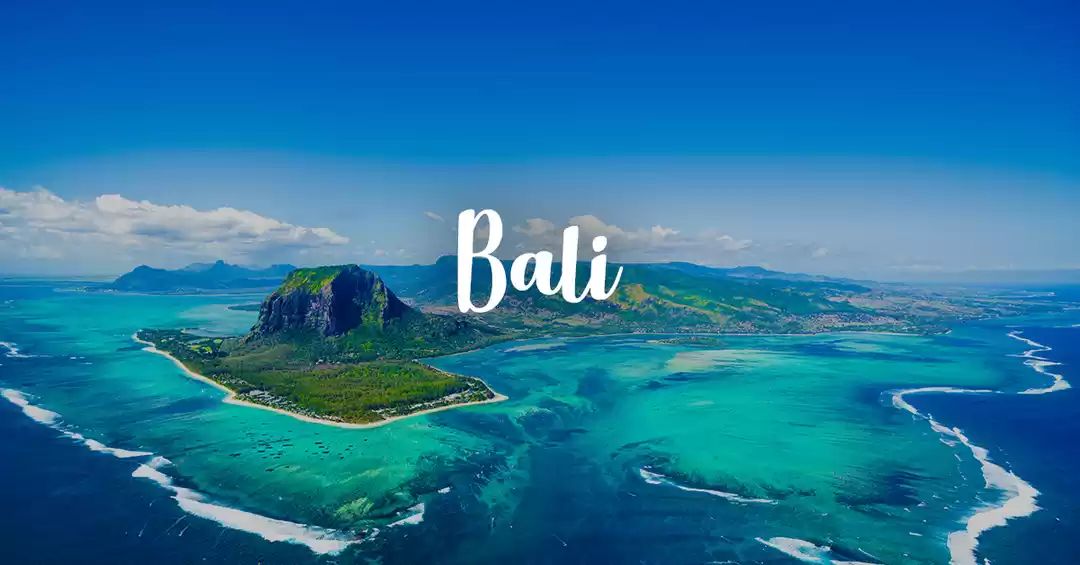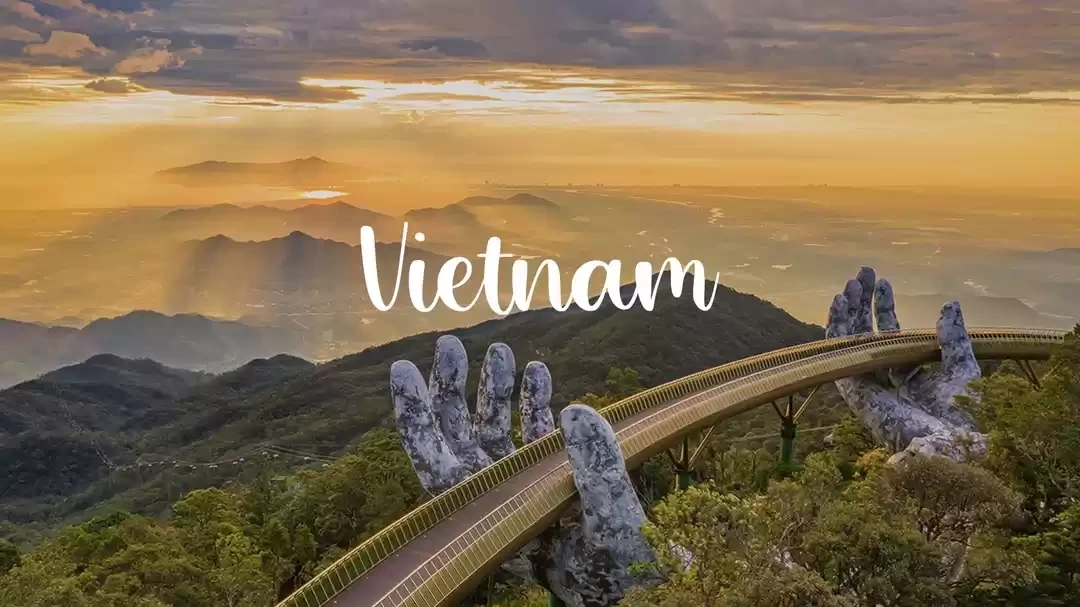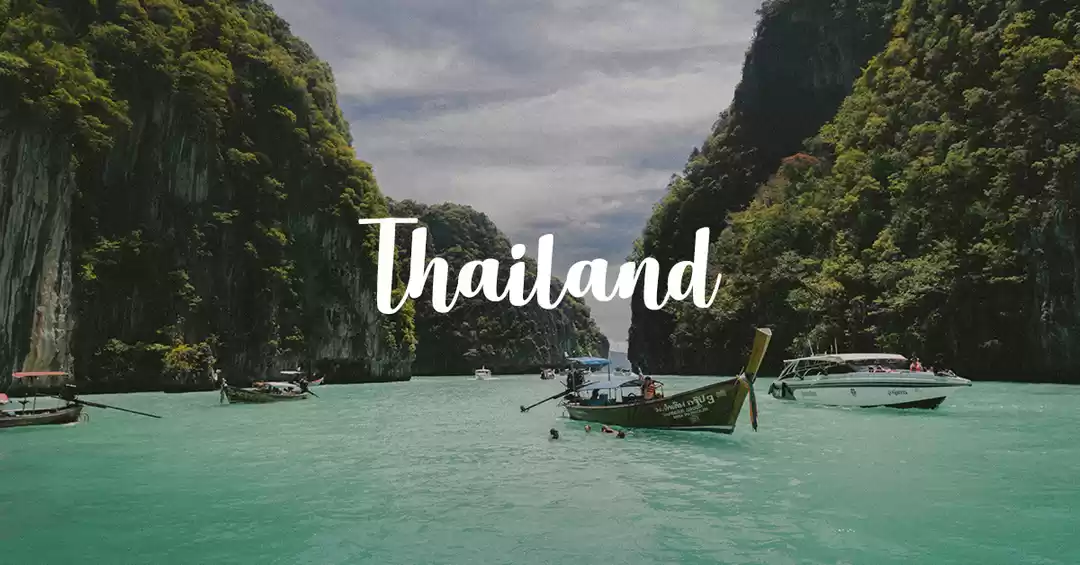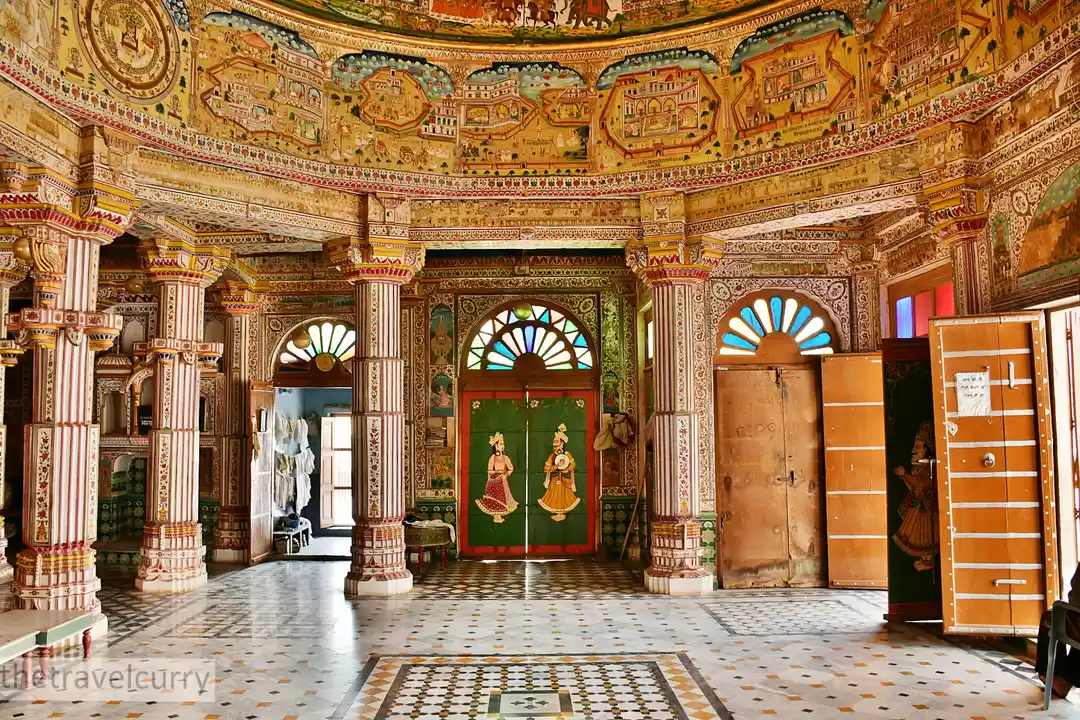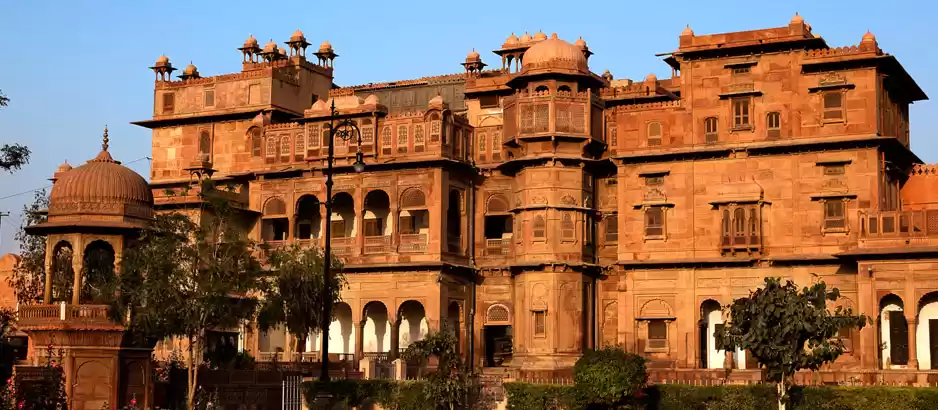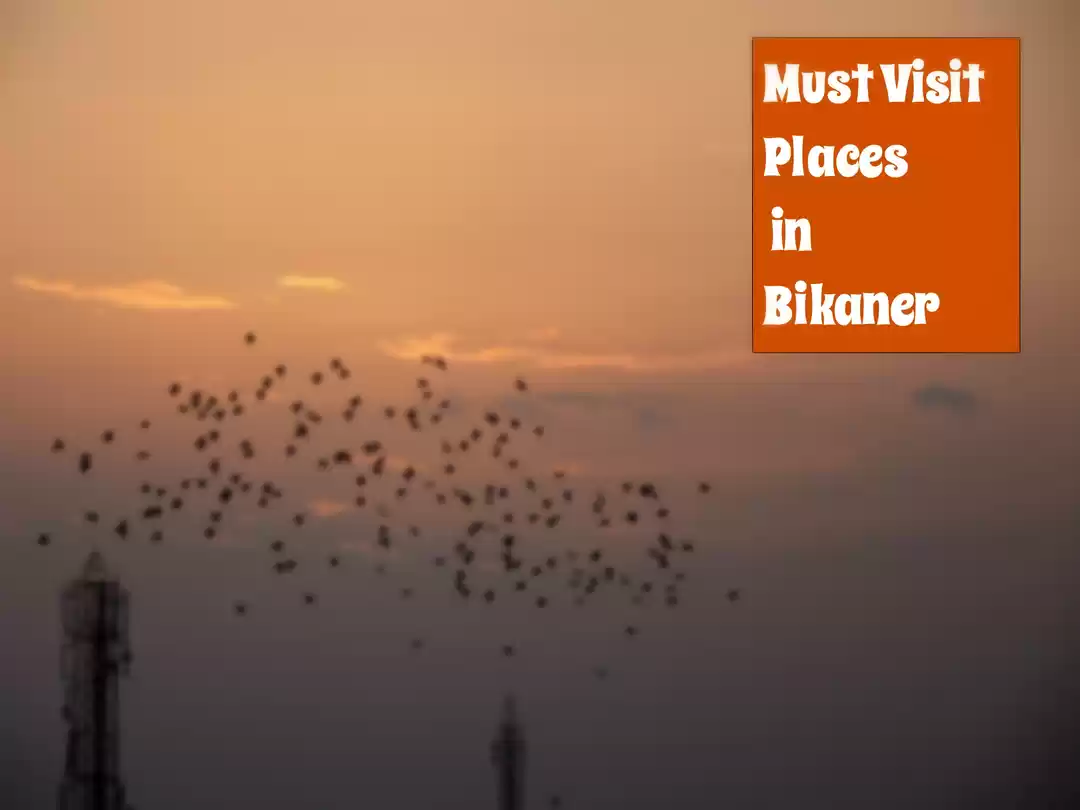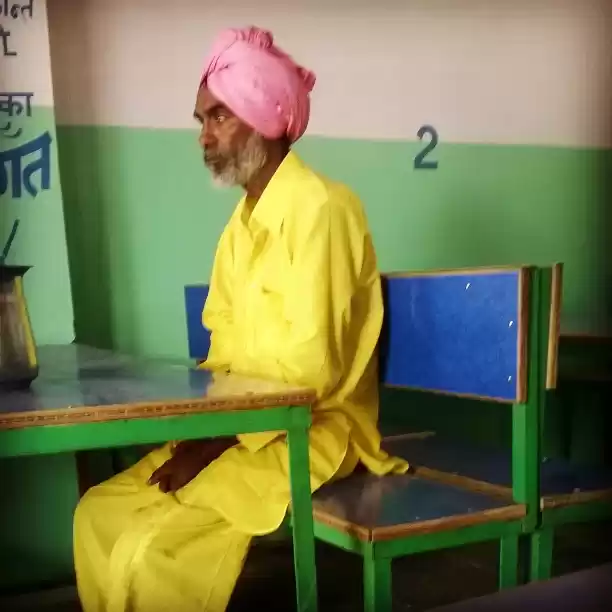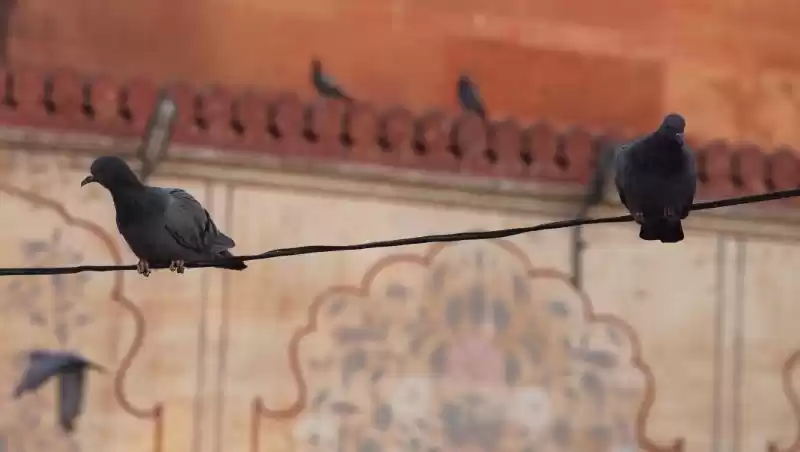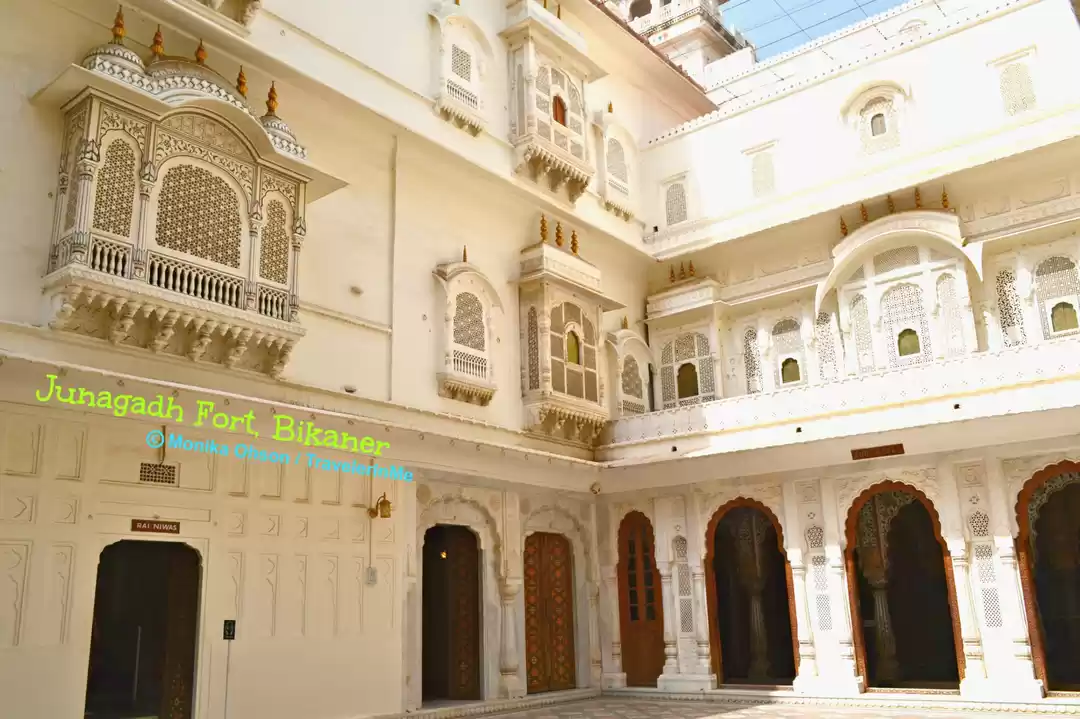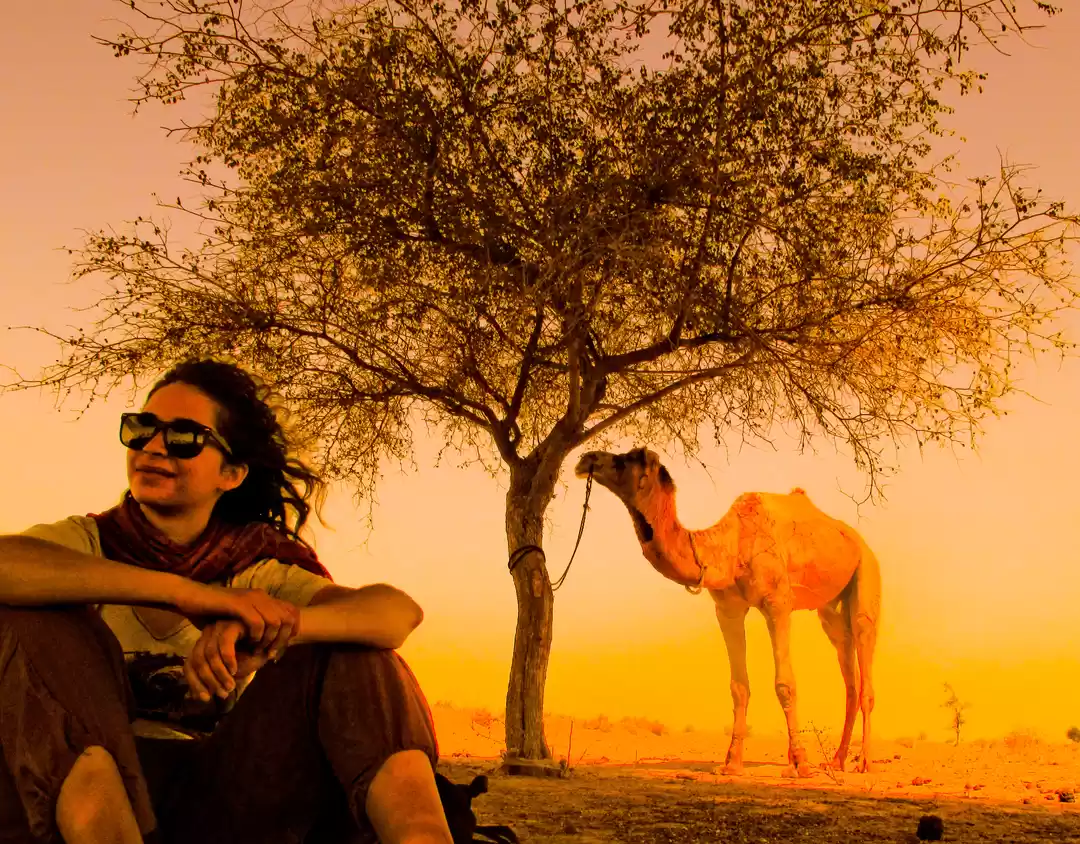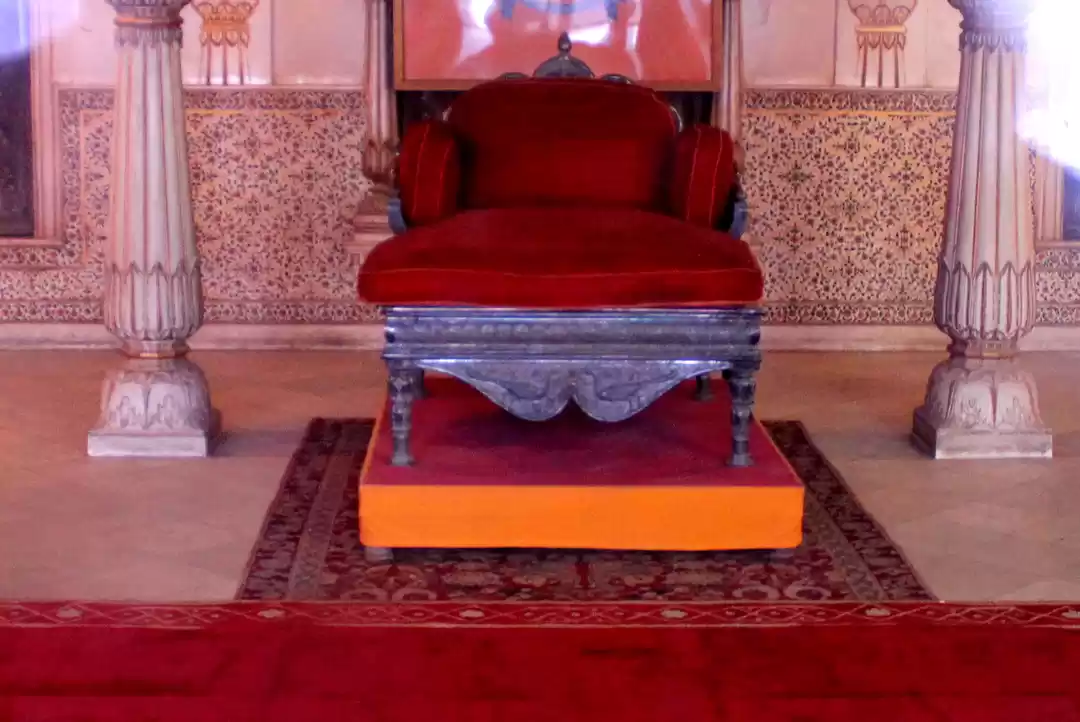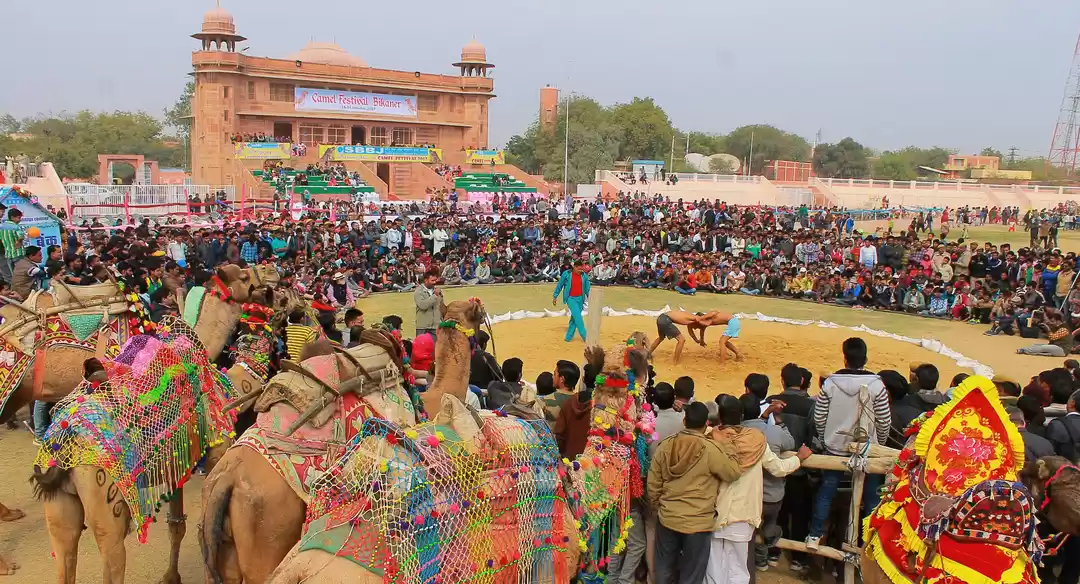Bikaner is home to one of the only two models of the biplane used by the British during World War I. They were presented by the British to Maharaja Ganga Singh, then ruler of the city. Another unique aspect about Bikaner are the sand dunes that are scattered throughout the district, especially from the north-east down to the southern area. Bikaner is situated in the northern region of Rajasthan. One of the earlier established cities, Bikaner still displays its ancient opulence through palaces and forts, built of red sandstone, that have withstood the passage of time. The city boasts of some of the world’s best riding camels and is aptly nicknamed ‘camel country’. It is also home to one of the world’s largest camel research and breeding farms; as well as being known for having its own unique temple dedicated to Karni Mata at Deshnok, called the Rats Temple. The origins of Bikaner can be traced back to 1488 when a Rathore prince, Rao Bikaji, founded the kingdom. Legend has it that Bikaji, one of Rao Jodhaji’s five sons, left his father’s Durbar in annoyance after an insensitive remark from his father, the illustrious founder of Jodhpur. Bikaji travelled far and when he came upon the wilderness called Jangladesh, he decided to set up his own kingdom and transformed it into an impressive city.
Come explore the wonders and sites that Bikaner has to offer. There’s always something to see in Rajasthan. JUNAGARH FORT Junagarh is an impregnable bastion that holds the distinction of having never been captured. It was constructed in 1588 AD by Raja Rai Singh, one of Emperor Akbar’s most distinguished generals. The fort complex houses some magnificent palaces constructed in red sandstone and marble and visitors can feast their eyes on an attractive assortment of courtyards, balconies, kiosks and windows. NATIONAL RESEARCH CENTRE ON CAMEL The National Research Centre on Camel is 8 kilometres from the city. This camel research and breeding centre is the only one of its kind in Asia. The centre is spread out over 2000 acres of semi-arid land and is managed by the Government of India. LALGARH PALACE AND MUSEUM Maharaja Ganga Singh commissioned the construction of this majestic palace. This architectural marvel is made entirely of red sandstone and was built in 1902 to commemorate his father, Maharaja Lal Singh. The design was conceptualised by Sir Swinton Jacob, who created this oriental fantasy by blending Rajputana, Islamic and European architecture. RAMPURIA HAVELI Bikaner has several havelis (aristocratic homes), the most famous cluster being the Rampuria Group of Havelis. Built of dulmera (red) stone, every aspect of the havelis – jharokhas (casements), entrances, latticed windows, divankhanas, gumaharias or basements – is simply exotic. Leaves and flowers decorate every jharokha, lending it a pleasant touch. These massive havelis are decorated with golden work of the highest quality. Their dankhanas (drawing room) take one back to the Mughal and Rajput era. One can notice an abundance of Victorian influence in their design as well. The wood carvings in Rampuria Havelies are extremely exquisite. Spaced close to each other, the havelis are truly a sight to behold. GANGA GOVERNMENT MUSEUM Described as the best museum in the State, the museum contains a rich display of archaeological artefacts from Harappa and the early Gupta periods. There are separate sections for paintings, arts and craft, woven carpets, clay pottery, ancient coins and Rajput weaponry. LAXMI NIWAS PALACE Laxmi Niwas Palace was the residence of the king of Bikaner, Maharaja Ganga Singh. Built between 1898 and 1902 by British architect Sir Samuel Swinton Jacob, this structure displays an Indo-Saracenic architectural style. It is now a luxury hotel. PRACHINA MUSEUM Located in the great Junagarh Fort, this museum hosts royal costumes, textiles and accessories of Rajasthani royalty. The 'Poshaks' (garments worn by ladies) are a reminder of the now lost craft of traditional designs, styles and workmanship. The family portraits on display narrate a story about how changing cultural settings influenced the style of immortalising the former rulers. DESHNOK KARNI MATA TEMPLE The Karni Mata Temple at Deshnok is a beautiful structure made of stone and marble, inside which resides an image of Karni Mata. The image is decorated with a ‘mukut’ (tiara) and garlands. The images of her sisters and the sisters of Avad Mata give her company on either side. The temple is known the world over for the presence of kabas (rats) that roam freely within the temple precincts. Know More JAIN TEMPLE BHANDASAR ain Temple Bhandasar is a 15th century temple dedicated to the 5th Tirthankar (a person that has conquered the cycle of life, death and rebirth and paved the path for others to attain nirvana), Sumatinathji, and is one of the oldest monuments of Bikaner. The temple design includes intricate mirror work, murals and gold leaf paintings. Devotees throng to the temple from all corners of the country. KODAMDESAR TEMPLE 24 kilometres from Bikaner is the Kodamdesar Temple. Kodamdesar Bhainru Ji was installed by Rao Bikaji sometime during the first three years of his arrival from Jodhpur. This place of worship was initially chosen as the site to lay the foundation of Bikaner, but was later shifted to its present location. SHRI LAXMINATH TEMPLE The rulers of Bikaner regarded Lord Laxminathji (Lord Vishnu) as the real king of Bikaner and themselves as his Deewans or Ministers. This temple, made of marble and red stone, was constructed to enshrine Lord Laxminath whose throne rests here. SHIV BARI TEMPLE Located just 6 kilometres from Bikaner, this Shiva temple is fortified by a high wall. It was commissioned and built by Maharaja Doongar Singh in the 19th century to commemorate his father Maharaja Lal Singh. The highlights of this red stone temple are beautiful wall paintings, the four-faced black marble Shiva statue and a bronze Nandi statue facing the Shiva-Lingam. The temple also houses two large reservoirs of water known as bawaris. GAJNER PALACE AND LAKE Gajner is an incomparable jewel of the Thar. The Gajner Palace was founded by Maharaja Gaj Singh ji of Bikaner in the year 1784, and then completed by the great Maharaja Ganga Singh of Bikaner on the banks of the lake. It was meant to serve as a hunting and relaxing lodge for the royal family as well as for visiting guests. It has now been converted into a hotel GAJNER WILDLIFE SANCTUARY Barely 32 kilometres from Bikaner, on the Jaisalmer road, is a lush green forest which is a haven to the nilgai, chinkara, black buck, wild boar, flocks of imperial sand grouse and many other species of migratory birds that make the sprawling forest their winter home. DEVI KUND 8 kilometres from Bikaner is the royal crematorium. It has several exquisite chhatris (cenotaphs), each dedicated to the memory of a ruler of the Bikaji dynasty and situated on the exact spot where each of them was cremated. The chhatri of Maharaj Surat Singh is a fine example of the architecture of that era. Devi Kund also has cenotaphs of 22 female members of the royal family prior to Maharaja Gaj Sigh Ji, who committed sati. There is also one cenotaph of a Sata (male sati) of a ruler. Maharaja Surat Singh's Chhatri is built entirely in white marble with spectacular Rajput paintings on its ceiling. RAJASTHAN STATE ARCHIVES Visitors to the archives are mostly researchers and academicians who come here to study the ancient administrative records that are preserved here. Some of the records date back to the Mughal period and include, among others, Persian Farmans, Nishans, Manshurs, etc. Records created during the administration of the various princely states of Rajasthan can also be found here. This exceptional collection is of immense value. KOLAYAT Kolayat is an important pilgrimage place for Hindus. Locals as well as devotees from distant places visit this temple complex every year. History tells the story of Kapil Muni, the advocate of Shankya yoga, who was so mesmerised by the serenity of this place that he interrupted his journey to the northwest and stopped here to carry out a ‘tapasya’ (penance) for the redemption of the world. The main attractions of the town are its several temples, ghats, the sacred lake and the town market. Kolayat is about 50 kilometres from Bikaner. KATARIASAR VILLAGE 45 kilometres from Bikaner on the Jaipur Road is a village rich in ethnic, rural and cultural life. In Katariasar, one can walk on sand dunes and view the sunset against the desert landscape. The main attraction of this village is its inhabitants, the Jasnathjis, who are fire dancers. Herds of chinkaras, desert foxes, rabbits, peacocks, parrots and partridges can be spotted here. JORBEED Bikaner in Rajasthan is one of the best places for birders if they want to spot some vultures. But, drive for about 12 km from the city, and you reach Jorbeed. If you are a birder, then Jorbeed is your ‘spot of opportunities’. Jorbeed is one of the best placesto look at raptors. Birds like the Steppe Eagles, Griffon Vultures, and Egyptian Vultures are as common as crows in this region. A place you’ll certainly have to come to terms with, you will hardly see a single tree here without some or the other raptor resting on it.A visit to Jorbeed is all about seeing the largest congregation of eagles and vultures in Asia, and if you are lucky, you might even spot the rare yellow-eyed pigeon here as well. With thousands of magnificent raptors dotting the landscape, Jorbeed is truly a birder’s paradise. HORSE ECOTOURISM The National Research Centre on equines, Bikaner Campus has recently taken an initiative to conserve and propagate equines through ecotourism. The Campus has now been opened for the Indian and Foreign tourists. The ambience of thecampus in itself is a big attraction. However, the campus has initiated Horse Riding, Pony Riding, Tonga Riding and Buggy Riding in the lush green zones of the campus to give nature-talking environment on one hand and a Desert Point with a traditional hut for the fragrance of the state, the Rajasthan, on the other hand. The elite Marwari horses, the Pride of Rajasthan; Kathiawari horses, the Elegance of Gujarat; Zanskari horses, the Ponies of Ladakh and Manipuri horses, the Famous Polo Ponies along with the French Poitou donkey and White Gujarati donkeys constitutes other major attractions. An Equine Information Centre has been developed for the depicting the basic technical details about the horses. The equine harness and implements are also worth seeing. The hydrotherapy pool for the natural treatment of equines is also worth visiting. Another beautiful part of the campus is the Souvenir shops offering the handicraft items, leather items and traditional Rajasthani dried vegetables for sale. DARBARI LAKE This lake is situated on Bikaner Jaisalmer Highway 33 KM far away from Bikaner city. This lake has the reputation of most popular picnic spot during the monsoon among the local people as well as tracking lover. Beauty of the lush green catchment area and ample water is something one most experience. RAISAR DUNES The site is situated on Bikaner Jaipur highway 18 Km far away from Bikaner city at Raisar village. This has been immersed as most prominent camping and safari site which has gathered prestigious place among the tourist for desert safari, camel safari, camel cart ride, jeep safari and night camping. PUBLIC PARK cgarden was constructed specially on the occasion of Maharaja Ganga Singh Ji in year 1937 and this garden is replica of Bukingham palace Garden, in the city of Westminster. HOW TO REACH HERE Nearest Airport NAAL 10 KM from Bikaner direct connectivity from Delhi as well as Jaipur. The bus stand is north of the city centre. There are frequent express buses to Agra, Ahmedabad, Ajmer, Barmer, Delhi, Jaipur, Jaisalmer, Jhunjhunu, Jodhpur, Kota and Udaipur. Bikaner has railway connections to several destinations in India including Jaipur, Jaisalmer, Churu, Jodhpur, Delhi, Mumbai, Kolkata, Guwahati etc. I WISH TO VISIT BIKANER PLAN YOUR TRIP District Website PLACES TO VISIT NEAR BIKANER icon JAISALMER 331 kms icon JAIPUR 350 kms icon AJMER 269 kms Subscribe to RSS Feed: Subscribe Discover Destinations Forts Palaces Museums Lakes Religious Places Wildlife National Police Memorial Experience Fairs & Festivals Luxury On Wheels Adventures Virtual Tours Heritage Properties Travel Diaries
BIKANER WELCOME TO CAMEL COUNTRY Bikaner is home to one of the only two models of the biplane used by the British during World War I. They were presented by the British to Maharaja Ganga Singh, then ruler of the city. Another unique aspect about Bikaner are the sand dunes that are scattered throughout the district, especially from the north-east down to the southern area. Bikaner is situated in the northern region of Rajasthan. One of the earlier established cities, Bikaner still displays its ancient opulence through palaces and forts, built of red sandstone, that have withstood the passage of time. The city boasts of some of the world’s best riding camels and is aptly nicknamed ‘camel country’. It is also home to one of the world’s largest camel research and breeding farms; as well as being known for having its own unique temple dedicated to Karni Mata at Deshnok, called the Rats Temple. The origins of Bikaner can be traced back to 1488 when a Rathore prince, Rao Bikaji, founded the kingdom. Legend has it that Bikaji, one of Rao Jodhaji’s five sons, left his father’s Durbar in annoyance after an insensitive remark from his father, the illustrious founder of Jodhpur. Bikaji travelled far and when he came upon the wilderness called Jangladesh, he decided to set up his own kingdom and transformed it into an impressive city. ATTRACTIONS & PLACES TO VISIT AND EXPLORE IN BIKANER TAB 2ARROW TAB 1ARROW TAB 3ARROW Come explore the wonders and sites that Bikaner has to offer. There’s always something to see in Rajasthan. JUNAGARH FORT Junagarh is an impregnable bastion that holds the distinction of having never been captured. It was constructed in 1588 AD by Raja Rai Singh, one of Emperor Akbar’s most distinguished generals. The fort complex houses some magnificent palaces constructed in red sandstone and marble and visitors can feast their eyes on an attractive assortment of courtyards, balconies, kiosks and windows. NATIONAL RESEARCH CENTRE ON CAMEL The National Research Centre on Camel is 8 kilometres from the city. This camel research and breeding centre is the only one of its kind in Asia. The centre is spread out over 2000 acres of semi-arid land and is managed by the Government of India. LALGARH PALACE AND MUSEUM Maharaja Ganga Singh commissioned the construction of this majestic palace. This architectural marvel is made entirely of red sandstone and was built in 1902 to commemorate his father, Maharaja Lal Singh. The design was conceptualised by Sir Swinton Jacob, who created this oriental fantasy by blending Rajputana, Islamic and European architecture. RAMPURIA HAVELI Bikaner has several havelis (aristocratic homes), the most famous cluster being the Rampuria Group of Havelis. Built of dulmera (red) stone, every aspect of the havelis – jharokhas (casements), entrances, latticed windows, divankhanas, gumaharias or basements – is simply exotic. Leaves and flowers decorate every jharokha, lending it a pleasant touch. These massive havelis are decorated with golden work of the highest quality. Their dankhanas (drawing room) take one back to the Mughal and Rajput era. One can notice an abundance of Victorian influence in their design as well. The wood carvings in Rampuria Havelies are extremely exquisite. Spaced close to each other, the havelis are truly a sight to behold. GANGA GOVERNMENT MUSEUM Described as the best museum in the State, the museum contains a rich display of archaeological artefacts from Harappa and the early Gupta periods. There are separate sections for paintings, arts and craft, woven carpets, clay pottery, ancient coins and Rajput weaponry. LAXMI NIWAS PALACE Laxmi Niwas Palace was the residence of the king of Bikaner, Maharaja Ganga Singh. Built between 1898 and 1902 by British architect Sir Samuel Swinton Jacob, this structure displays an Indo-Saracenic architectural style. It is now a luxury hotel. PRACHINA MUSEUM Located in the great Junagarh Fort, this museum hosts royal costumes, textiles and accessories of Rajasthani royalty. The 'Poshaks' (garments worn by ladies) are a reminder of the now lost craft of traditional designs, styles and workmanship. The family portraits on display narrate a story about how changing cultural settings influenced the style of immortalising the former rulers. DESHNOK KARNI MATA TEMPLE The Karni Mata Temple at Deshnok is a beautiful structure made of stone and marble, inside which resides an image of Karni Mata. The image is decorated with a ‘mukut’ (tiara) and garlands. The images of her sisters and the sisters of Avad Mata give her company on either side. The temple is known the world over for the presence of kabas (rats) that roam freely within the temple precincts. Know More JAIN TEMPLE BHANDASAR ain Temple Bhandasar is a 15th century temple dedicated to the 5th Tirthankar (a person that has conquered the cycle of life, death and rebirth and paved the path for others to attain nirvana), Sumatinathji, and is one of the oldest monuments of Bikaner. The temple design includes intricate mirror work, murals and gold leaf paintings. Devotees throng to the temple from all corners of the country. KODAMDESAR TEMPLE 24 kilometres from Bikaner is the Kodamdesar Temple. Kodamdesar Bhainru Ji was installed by Rao Bikaji sometime during the first three years of his arrival from Jodhpur. This place of worship was initially chosen as the site to lay the foundation of Bikaner, but was later shifted to its present location. SHRI LAXMINATH TEMPLE The rulers of Bikaner regarded Lord Laxminathji (Lord Vishnu) as the real king of Bikaner and themselves as his Deewans or Ministers. This temple, made of marble and red stone, was constructed to enshrine Lord Laxminath whose throne rests here. SHIV BARI TEMPLE Located just 6 kilometres from Bikaner, this Shiva temple is fortified by a high wall. It was commissioned and built by Maharaja Doongar Singh in the 19th century to commemorate his father Maharaja Lal Singh. The highlights of this red stone temple are beautiful wall paintings, the four-faced black marble Shiva statue and a bronze Nandi statue facing the Shiva-Lingam. The temple also houses two large reservoirs of water known as bawaris. GAJNER PALACE AND LAKE Gajner is an incomparable jewel of the Thar. The Gajner Palace was founded by Maharaja Gaj Singh ji of Bikaner in the year 1784, and then completed by the great Maharaja Ganga Singh of Bikaner on the banks of the lake. It was meant to serve as a hunting and relaxing lodge for the royal family as well as for visiting guests. It has now been converted into a hotel GAJNER WILDLIFE SANCTUARY Barely 32 kilometres from Bikaner, on the Jaisalmer road, is a lush green forest which is a haven to the nilgai, chinkara, black buck, wild boar, flocks of imperial sand grouse and many other species of migratory birds that make the sprawling forest their winter home. DEVI KUND 8 kilometres from Bikaner is the royal crematorium. It has several exquisite chhatris (cenotaphs), each dedicated to the memory of a ruler of the Bikaji dynasty and situated on the exact spot where each of them was cremated. The chhatri of Maharaj Surat Singh is a fine example of the architecture of that era. Devi Kund also has cenotaphs of 22 female members of the royal family prior to Maharaja Gaj Sigh Ji, who committed sati. There is also one cenotaph of a Sata (male sati) of a ruler. Maharaja Surat Singh's Chhatri is built entirely in white marble with spectacular Rajput paintings on its ceiling. RAJASTHAN STATE ARCHIVES Visitors to the archives are mostly researchers and academicians who come here to study the ancient administrative records that are preserved here. Some of the records date back to the Mughal period and include, among others, Persian Farmans, Nishans, Manshurs, etc. Records created during the administration of the various princely states of Rajasthan can also be found here. This exceptional collection is of immense value. KOLAYAT Kolayat is an important pilgrimage place for Hindus. Locals as well as devotees from distant places visit this temple complex every year. History tells the story of Kapil Muni, the advocate of Shankya yoga, who was so mesmerised by the serenity of this place that he interrupted his journey to the northwest and stopped here to carry out a ‘tapasya’ (penance) for the redemption of the world. The main attractions of the town are its several temples, ghats, the sacred lake and the town market. Kolayat is about 50 kilometres from Bikaner. KATARIASAR VILLAGE 45 kilometres from Bikaner on the Jaipur Road is a village rich in ethnic, rural and cultural life. In Katariasar, one can walk on sand dunes and view the sunset against the desert landscape. The main attraction of this village is its inhabitants, the Jasnathjis, who are fire dancers. Herds of chinkaras, desert foxes, rabbits, peacocks, parrots and partridges can be spotted here. JORBEED Bikaner in Rajasthan is one of the best places for birders if they want to spot some vultures. But, drive for about 12 km from the city, and you reach Jorbeed. If you are a birder, then Jorbeed is your ‘spot of opportunities’. Jorbeed is one of the best placesto look at raptors. Birds like the Steppe Eagles, Griffon Vultures, and Egyptian Vultures are as common as crows in this region. A place you’ll certainly have to come to terms with, you will hardly see a single tree here without some or the other raptor resting on it.A visit to Jorbeed is all about seeing the largest congregation of eagles and vultures in Asia, and if you are lucky, you might even spot the rare yellow-eyed pigeon here as well. With thousands of magnificent raptors dotting the landscape, Jorbeed is truly a birder’s paradise. HORSE ECOTOURISM The National Research Centre on equines, Bikaner Campus has recently taken an initiative to conserve and propagate equines through ecotourism. The Campus has now been opened for the Indian and Foreign tourists. The ambience of thecampus in itself is a big attraction. However, the campus has initiated Horse Riding, Pony Riding, Tonga Riding and Buggy Riding in the lush green zones of the campus to give nature-talking environment on one hand and a Desert Point with a traditional hut for the fragrance of the state, the Rajasthan, on the other hand. The elite Marwari horses, the Pride of Rajasthan; Kathiawari horses, the Elegance of Gujarat; Zanskari horses, the Ponies of Ladakh and Manipuri horses, the Famous Polo Ponies along with the French Poitou donkey and White Gujarati donkeys constitutes other major attractions. An Equine Information Centre has been developed for the depicting the basic technical details about the horses. The equine harness and implements are also worth seeing. The hydrotherapy pool for the natural treatment of equines is also worth visiting. Another beautiful part of the campus is the Souvenir shops offering the handicraft items, leather items and traditional Rajasthani dried vegetables for sale. DARBARI LAKE This lake is situated on Bikaner Jaisalmer Highway 33 KM far away from Bikaner city. This lake has the reputation of most popular picnic spot during the monsoon among the local people as well as tracking lover. Beauty of the lush green catchment area and ample water is something one most experience. RAISAR DUNES The site is situated on Bikaner Jaipur highway 18 Km far away from Bikaner city at Raisar village. This has been immersed as most prominent camping and safari site which has gathered prestigious place among the tourist for desert safari, camel safari, camel cart ride, jeep safari and night camping. PUBLIC PARK cgarden was constructed specially on the occasion of Maharaja Ganga Singh Ji in year 1937 and this garden is replica of Bukingham palace Garden, in the city of Westminster. HOW TO REACH HERE Nearest Airport NAAL 10 KM from Bikaner direct connectivity from Delhi as well as Jaipur. The bus stand is north of the city centre. There are frequent express buses to Agra, Ahmedabad, Ajmer, Barmer, Delhi, Jaipur, Jaisalmer, Jhunjhunu, Jodhpur, Kota and Udaipur. Bikaner has railway connections to several destinations in India including Jaipur, Jaisalmer, Churu, Jodhpur, Delhi, Mumbai, Kolkata, Guwahati etc.





























